| Designation: | OT-64 SKOT |
 |
|---|---|---|
| Manufacturer: | VOP CZ, s.p. | |
| Product type: | Armoured Vehicles | |
| Name: | Wheeled armoured personnel carrier |
The OT-64 (Obrneny Transporter) Armoured Personnel Carrier (APC) was jointly developed from 1959 by Czechoslovakia and Poland was used by them in place of the similar Russian BTR-60 (8 × 8) APC.
The vehicle, which uses many automotive components of the Tatra 813 series of 8 × 8 high-mobility trucks, entered service in 1964 and was subsequently widely exported.
The Polish designation for the vehicle is the Sredni Kolowy Opancerzny Transporter. Tatra of Czechoslovakia provided the chassis and automotive components and FSC/Lubin in Poland the armoured body and weapon system. Production of the OT-64 family was completed in 1990 after about 10,300 had been built for the home and export markets.
Although production of the OT-64 was completed many years ago the Czech Republic still has quantities of these vehicles available for export, see the OT-93 APC later on in this entry. Description
The hull of the OT-64 (8 × 8) APC is made of all-welded steel, with the crew compartment at the front, engine behind and the troop compartment at the very rear. This model has recently been called the OT-64A by the Czech Republic.
The driver is seated at the front of the vehicle on the left side with the commander to his right, both with a single-piece rear-opening door beside them. The driver has a single-piece hatch cover that opens to the rear and three day periscopes for vision to the front and sides. The commander has a single-piece hatch cover that opens forwards with a day periscope in its forward part, which can be traversed through 360°. On the roof, between the driver's and commander's positions, is a searchlight which can be operated from inside the vehicle.
The Tatra 928-18 V-8 diesel engine is behind the commander and driver with the air inlet and outlets on the top of the hull and the exhaust pipes on either side of the hull.
The turret is in the centre of the vehicle and is mounted on an eight-sided plinth to enable the weapon to have some depression.
The troop compartment is at the rear of the vehicle and the troops enter and leave by two doors in the rear of the hull, each of which has a firing port. Over the top of the troop compartment are four roof hatches, each with a firing port, hinged on the outside. If required, the roof hatches can be locked vertical. There are two firing ports in each side of the troop compartment. The infantrymen are seated down each side of the vehicle on seats, which can be folded up to allow the vehicle to be used for cargo.
Steering is powered on the front four wheels and all eight tyres are provided with a tyre pressure regulation system, which allows the driver to adjust the tyre pressure to suit the type of ground being crossed. The vehicle is fully amphibious being propelled in the water by two propellers mounted at the rear of the hull. Before entering the water, a trim vane is erected at the front of the vehicle; when travelling, it is stowed on the glacis plate. Standard equipment on all vehicles includes an overpressure NBC system, a winch mounted at the front of the hull and bilge pumps.
A tow hook is provided at the front of the hull with a trailer coupling being provided at the rear. Maximum trailer weight is 3,000 kg, including payload.
The one-man manually operated turret is similar to those fitted to the Russian BRDM-2 (4 × 4) reconnaissance vehicle and BTR-60PB (8 × 8) APC and is armed with a 14.5 mm KPVT machine gun with a 7.62 mm PKT machine gun mounted to the right of the main armament and the sight to the left. The weapons have a maximum elevation of +29°, depression of -4° and 360° turret traverse. Some models have been observed many years ago with a single Kolomna KBM 9K11 Malyutka (NATO AT-3 'Sagger') ATGW mounted on each side of the turret with lateral armour protection. Variants
In both former Czech and Polish service these vehicles are officially designated SKOT, SKOT-2, SKOT-2A and SKOT-2AP. The designations OT-64A, OT-64B, OT-64C(1) and OT-64C(2) are not always used. The Czech Republic has declared its vehicles under the CFE Treaty as being the OT-64, not SKOT, with the basic vehicle being the OT-64 and the model with the Russian type 7.62/12.7 mm machine gun turret being the OT-64A.
This is the basic member of the series. Some are unarmed while those used by Poland are fitted with a pintle-mounted 7.62 mm machine gun. There are five hatches over the troop compartment: two open to the left and right of the vehicle, the centre one opens forwards and the last two open to the left and right. All of them can be locked vertical. Some OT-64As have been observed with two Kolomna KBM 9K11 Malyutka (NATO AT-3 'Sagger') ATGWs mounted over the top of the troop compartment. Four Kolomna KBM 9K11 Malyutka (NATO AT-3 'Sagger') ATGWs are carried.
This model has only been used by Poland and has a square plinth with a pintle-mounted 7.62 mm or 12.7 mm machine gun. It has a shield that gives front and side protection to the gunner, but has an open top and is open at the rear. The OT-64B has three hatches over the troop compartment, the first one opens forwards and the other two open either side. This was probably a temporary expedient pending the delivery of turrets.
This is the model described in detail earlier.
This is used only by Poland and is similar to the OT-64C(1) except that it has a new turret with a curved top. It is armed with a 14.5 mm KPVT machine gun with a 7.62 mm PKT machine gun mounted to the right of the main armament and the sight to the left. The weapons have a depression of -4° and an elevation of +89.5° which allows them to be used against helicopters and aircraft. Some vehicles have been observed with a single Kolomna KBM 9K11 Malyutka (NATO AT-3 'Sagger') ATGW mounted either side of the turret. This turret is also installed on the OT-62C tracked armoured personnel carrier.
The turret was developed by the WAT Military Technical Institute and is fitted with a CGS-90 sight.
Morocco is known to have some OT-64C(1) (SKOT-2A) APCs with the original turret replaced by the same turret installed on the full tracked OT-62B.
This is an OT-64 modified for use in the repair role. Its correct designation is the DTP-64 (Dilna Technike Pomoci) and it has two gas bottles on the roof.
Former Czech command variant of the OT-64A. Polish Army designation for this model is the SKOT R-2AM with another variant being the SKOT R-2M. These are the OT-64A/SKOT-2A with periscopes and the eight-sided plinth, generator and antenna. All other R versions also have this plinth but without the armed turret.
This is an artillery command vehicle equipped with an R-130, two R-123Z and R-809 radios. This model can be identified by a collapsible Half Horse antenna on the right side of the roof, a generator on the rear deck and a telescopic antenna on the right rear.
Former Czech version of the OT-64 with radio equipment. Polish Army designation for this model is the SKOT R-3M. These are also command vehicles and are similar to the R-2AM, but with the telescopic antenna on the left side of the hull.
Communications equipment includes an R-130, two R-123Z, an R-111, an R-405PT-1, an R-126, a K-1 and a K-2.
This command vehicle is similar to the R-2AM but with a telescopic antenna on the left and right rear.
Former Czech version of the OT-64 with radio equipment. It is identified by a sword antenna on the front side of the plinth and has an additional door in the left side of the hull, behind the exhaust pipe. No frame type antenna is fitted.
This is an unknown Czech command version.
This command vehicle is similar to the R-3Z but can be identified by a sword antenna and a generator to the immediate rear of the plinth.
This is an air defence artillery command vehicle with the same mission as the Russian BTR-60Pu-12. It has no frame antenna but two telescopic antennas.
This is an engineer vehicle based on the basic SKOT and can be identified by grab handles over the rear engine deck and another two behind the exhaust pipes. These bars are believed to be fitted to avoid mine clearance hoses being ignited by the heat of the engine.
This version has been declared under the CFE Treaty and is believed to be fitted with loudspeakers.
More recently a new version of the SKOT (8 × 8) APC, called the OT-93, has been developed and this is now being offered for the export market.
The OT-63 is basically the SKOT-2A with the original one-person turret armed with a 14.5 mm KPVT and 7.62 mm PKT machine gun removed and replaced by a turret armed with a single 7.62 mm UK-59T machine gun.
Turret traverse is 360° with weapon elevation from -5 to +80°. Turret traverse and weapon elevation is manual.
This turret is the same as that fitted to the OT-65A (4 × 4) reconnaissance vehicle and the OT-62B full-tracked APC.
With the downsizing of the Czech Republic Army, quantities of OT-64 vehicles are now surplus to requirement and are being offered on the export market in a number of configurations.
As well as the OT-93, other versions of the OT-64 vehicle are being offered including police, firefighting, recovery/repair and bullion carrier.
The Polish-based company of PCO (Przemyslowe Centrum Optyki) is now offering a complete electro-optical upgrade suite for the SKOT (8 × 8) Armoured Personnel Carrier (APC). These PCO systems are of the Image Intensification (II) type.
The driver is seated at the front of the vehicle on the left side. PCO is offering two alternatives, the PNS-1 driver's night-vision goggles and the PNK-55 night-vision periscope.
The PNS-1 night-vision goggles are typically attached to the driver's head using a harness and have a magnification of ×1 and a minimum field of view of 38°.
The PNK-55 night-vision periscope is a direct replacement for the day periscope and has a magnification of ×1 and a 30° field of a view and requires an 18-30 V DC power supply. It has an effective range of about 300 m compared to the 100 m of the original equipment.
The commander is seated to the right of the driver and PCO is offering two solutions. First is the TKN-1Z passive night-vision periscope with a magnification of ×3 and a 10° field of view.
Second is the more sophisticated modernised TKN-3Z periscope that has two channels, day and night. The day channel magnification of ×4.75 and a 9° 30' field of view while the night channel has magnification of ×4.2 and a 11° 30' field of view. In the night mode these have a maximum range of 1,100 m compared to 400 m of the first generation system.
Some versions of the SKOT are fitted with a one-person turret armed with a 14.5 mm KPVT and one 7.62 mm PKT machine gun. This turret is identical to that installed on a number of other AFVs, such as the Russian BRDM-2 (4 × 4) scout car which is still widely deployed around the world.
For this version of the SKOT, PCO is offering its CDN-1 periscopic day/night sight. The day and night channels have a magnification of ×3.7 and a 10.5° field of view, with an 18-30 V DC power supply required.
In Bosnia, a number of SKOT-2A vehicles were observed. These had their turrets removed and plated over and a simple cupola with a rear-opening hatch cover fitted. On the forward part of this cupola is a 12.7 mm machine gun in an unprotected mount.
Repair and maintenance version of the OT-64 that is fitted with a light crane for changing components in the field. Armament consists of a 7.62 mm PKT machine gun. It is fitted with an A-frame and is also referred to as the SKOT WPT.
- SKOT R-3Z is Polish OT-64 R-3Z
- SKOT R-4 is Polish OT-64 R-4
- SKOT R-6 is Polish OT-64 R-6
- SKOT S-260 is Polish engineer vehicle for laying mines. This is called the S-260 Inz (Inzynieryjny)
- S-260 Art. This is the artillery re-supply vehicle (Artyleryjski)
- SKOT WPT is Polish repair and maintenance vehicle and is equivalent of Czech WPT. This was never used by the Czech or Slovak Armies, who had the DTP-64. It is no longer in front-line service with Poland.
Military Motorization Works No 5 in Poland has upgraded an OT-64 (8 × 8) APC in a number of key automotive areas to extend its operational life. These modifications include the following:
- Replacement of the original diesel engine by a Cursor 8 series diesel developing 310 hp
Upgrading the vehicle's transmission
- Installation of a new and improved driver's dashboard
- Installation of a fully automated system with onboard computer to work with a defence system against weapons of mass destruction
- New batteries
- Installation of an air conditioning system
- New electrical system using Raychem technology and automatic fuse system
- Installation of two independent automatic sump pumps with electrically powered volume
This is Lynx fitted with a remote-control weapon system armed with a 12.7 mm MG.
This is Lynx fitted with a ZSMU Kobuz remote-controlled weapon station armed with a 12.7 mm MG or a 7.62 mm UKM-200C MG.
IRBIS RCWS
This is the Lynx fitted with the RAFAEL Remote Control Weapon System (RCWS) armed with 30 mm cannon, 7.62 mm co-axial MG and a twin launcher on left side for Spike Long Range ATGW.
This is a medical evacuation vehicle based on the upgraded Lynx and has a raised roof line towards the rear for increased internal volume. It carries specialised medical equipment and in addition to its crew of four can also carry four stretcher patients or eight seated patients.
This 6 × 6 vehicle has been developed to the prototype stage and weighs 11 tonnes and has a maximum road speed of 100 km/h and a maximum water speed of 10 km/h. Standard equipment includes an air conditioning system, NBC system, 5.4 tonne capacity electric winch and fire detection and suppression system. Baseline vehicle can be adopted for a wide range of roles.
This is also referred to as the Azalia and is for use with the 155 mm/52 calibre Krab self-propelled artillery system that has yet to enter service with Poland.
Standard equipment includes FONET on board communications system, on board terminal DD9620, terminals BFC 201, line traction panels, 12.5 kWA power generation unit, air conditioning system, heating system, digital VHF radios, switchboard multiplexer, navigation system and fire/explosion detection and suppression system.
This includes all of the automotive upgrades covered above plus the following additional upgrades:
- Automatic control system in the transmission for engaging front and rear drives and engaging full terrain drive, for example 8 × 8
- Vehicle lighting system upgraded to meet latest traffic regulations
- Installation of RRC 9500 digital radio station
- Installation of FONET digital intercom system
- Installation of modernised filtration ventilation system
- Installation of day/night passive observation device for the vehicle commander
- Installation of new electric generation system using fuel from the vehicle's main diesel fuel tank and with its own emergency fuel tank with automatic fuel refilling
- Installation of command terminal servicing the carrier system and onboard systems
- Installation of TAFIOS and PANDORA reconnaissance and defence systems against the effects of weapons of mass destruction
- Installation of a SPECTREX fire-prevention and anti-explosive systems
- Installation of an automated command system
- Installation of an automated reconnaissance system workstation
- Installation of a KF TRC 3630 radio station
- Installation of a UKF radio station
- Installation of an automated command post workstation
- An integrated navigation system has been fitted
- A system of protection against laser radiation has been installed
Other equipment fitted includes an NBC system, electric winch with a capacity of 5,400 kg and a fire protection system. It can also be fitted with various overhead weapon systems including a RAFAEL Remote Controlled Weapon Station armed with a 12.7 mm machine gun. Basic specifications of the upgraded OT-64 without a weapon station are given in the table.
This would typically be fitted with the FONET onboard communications system, onboard terminal DD 9620, terminal BFC 201, line traction panels, 12.5 kvA generator, air-conditioning system, heating system, digital VHF transmitter/receiver RRC-9500, LK 24A switchboard multiplexer, TRZ power distribution panel, digital radio link, MK61A communication module, RK-128/2 cable regenerator, cryptographic device, 12 or 24 m antenna mast, automatic command system station Szafran, LITEF land navigation system, onboard VHF transmitter/receiver Harris Falcon II RF-5800H 150 W and a Deugra explosion protection system.
This is an upgraded OT-64 with many of the above modifications plus the following additional features:
- Installation of Signall silent battlefield reconnaissance and observation system
- Installation of Thales long-range reconnaissance and observation system with optro-electronic head and operational observation workstation
- Installation of a command terminal servicing the carrier system and onboard electric systems
It is expected that when the Polish Army fields the Krab 155 mm/52 calibre self-propelled artillery system the battery and battalion command vehicle will be based on an upgraded Rys vehicle. This vehicle is referred to as the Lynx - WD/WDSz.
For trials purposes the Polish Rys vehicle has been fitted with the German Rheinmetall Landsysteme E8 one-person power-operated turret armed with a 30 mm cannon, 7.62 mm coaxial machine gun and a computerised day/night fire-control system. As of mid-2007 this combination remained at the prototype stage. The turret has also been tested on other chassis.
For trials purposes, a Polish OT-64 has been modified into a fire-command vehicle and 98 mm mortar carrier. The roof of the vehicle has been raised to the rear of the third road wheel station either side and fitted with new twin doors that open left and right.
The two-wheeled 98 mm muzzle-loaded mortar can be rapidly loaded and unloaded using two ramps positioned at the rear of the vehicle. This version features all of the improvements to the Rys previously mentioned, such as new Cursor 8 series diesel engine developing 310 hp, batteries, air-conditioning system and new driver's dashboard. All of these upgraded Polish OT-64 Rys APCs and variants can be fitted with additional composite armour plates developed in Poland.
Following a competition in mid-2006 the Czech Republic selected the Austrian Steyr-Daimler-Puch Pandur II (8 × 8) with an initial batch of 199 ordered plus an option on another 35.
This full-tracked armoured personnel carrier is the Czech equivalent of the Russian BTR-50 with some enhancements. It is still used by some countries.
|
||||||||||||||
|
|||||||||
Related Articles |
|
Czech Government Approves Major Military Order (16.04.2005) |
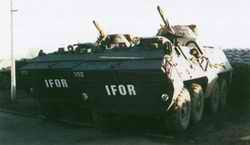 |
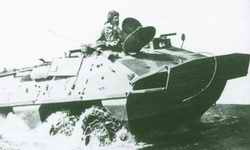 |
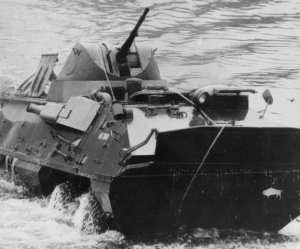 |
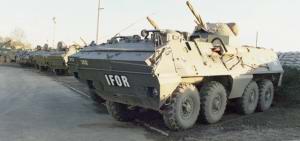 |
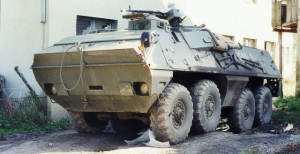 |
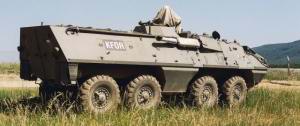 |
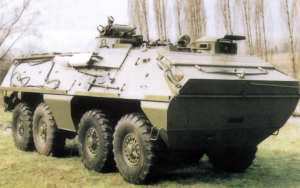 |
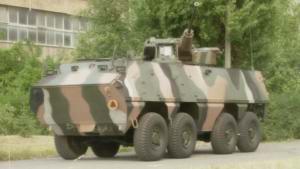 |
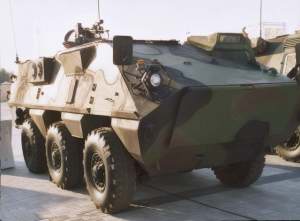 |
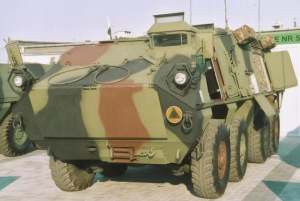 |













